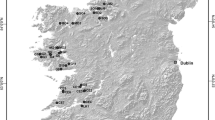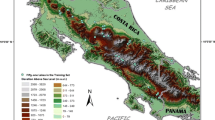Abstract
A major goal of paleolimnological studies is the quantification of past environmental conditions. This is accomplished by computing transfer functions relating organism assemblages to environmental factors. The environmental data are typically comprised of a point sample of water chemistry and other environmental parameters that are collected at the same time as a surface sediment sample. We explore whether the year of sampling of the environmental variables affects the parameterization of organism-environment relations, in particular chironomids, ostracodes and diatoms. Canonical correspondence analyses revealed that the year of sampling is of secondary importance when relating the organism assemblages to environmental variables, but only with the major explanatory variables. A chironomid-inferred bottom water temperature partial least squares transfer function revealed similar performance statistics between the years. Taxon optima and tolerances were computed for both years using weighted averaging, and the results are comparable. A paired t-test computed on the proxy-inferred bottom water temperature values indicated that the results between the 2 years are not statistically different. The results of this study provide guarded optimism that the methodology of estimating transfer functions as currently applied is not entirely determined by the particular year when the data were collected, although more case studies are needed.






Similar content being viewed by others
References
Armstrong FAJ, Schindler DW (1971) Preliminary chemical characterization of waters in the Experimental Lakes Area, Northwestern Ontario. J Fish Res Board Can 28:171–187
Barley EM, Walker IR, Kurek J, Cwynar LC, Mathewes RW, Gajewski K, Finney BP (2006) A northwest North American training set: distribution of freshwater midges in relation to air temperature and lake depth. J Palelimnol 36:295–314
Birks HJB (1995) Quantitative palaeoenvironmental reconstructions. In: Maddy D, Brew JS (eds) Statistical modelling of quaternary science data. Quaternary Research Association, Cambridge, pp 161–254
Birks HJB (1998) Numerical tools in palaeolimnology: progress, potentialities, and problems. J Paleolimnol 20:307–332
Bouchard G, Gajewski K, Hamilton PB (2004) Freshwater diatom biogeography in the Canadian Arctic Archipelago. J Biogeogr 31:1955–1973
Bradshaw EG, Anderson NJ, Jensen JP, Jeppensen E (2002) Phosphorus dynamics in Danish lakes and the implications for diatom ecology and palaeoecology. Freshw Biol 47:1963–1975
Brinkhurst RO (1974) The Benthos of lakes. Blackburn Press, Caldwell, New Jersey
Brock TD (1985) A eutrophic lake, Lake Mendota, Wisconsin. Springer-Verlag, New York
Bunbury J, Gajewski K (2005) Quantitative analysis of freshwater ostracode assemblages in southwestern Yukon Territory, Canada. Hydrobiologia 545:117–128
Delorme LD (1991) Ostracoda. In: Thorp JH, Covich AP (eds) North American freshwater invertebrates. Academic Press, Toronto, pp 691–717
Eggermont H, De Deyne P, Berschuren D (2007) Spatial variability of chironomid death assemblages in the surface sediments of a fluctuating tropical lake (Lake Naivasha, Kenya). J Paleolimnol, doi 10.1007/s10933-006-9075-9
Glew JR (1991) Miniature gravity corer for recovering short sediment cores. J Paleolimnol 5:285–287
Håkanson L (2004) Lakes: form and function. Blackburn Press, Caldwell, New Jersey
Hamilton P, Gajewski K, Atkinson D, Lean D (2001) Physical and chemical limnology of lakes from the Canadian Arctic Archipelago. Hydrobiologia 457:133–148
Harris GP, Baxter G (1996) Interannual variability in phytoplankton biomass and species composition in a subtropical reservoir. Freshw Biol 35:545–560
Heiri O (2004) Within-lake variability of subfossil chironomid assemblages in shallow Norwegian lakes. J Paleolimnol 32:67–84
Hill MO, Gauch HG (1980) Detrended correspondence analysis: an improved ordination technique. Vegetatio 42:47–58
Hutchinson GE (1944) Limnological studies in Connecticut. VII. A critical examination of the supposed relationship between phytoplankton periodicity and chemical changes in lake waters. Ecology 25:3–26
Juggins S (2003) C2 user guide. Software for ecological and palaeoecological data analysis and visualisation. University of Newcastle, Newcastle upon Tyne, UK
Kattel GR, Battarbee RW, Mackay A, Birks HJB (2007) Are cladoceran fossils in lake sediment samples a biased reflection of the communities from which they are derived? J Paleolimnol, doi 10.1007/s10933-006-9073-y
Köster D, Pienitz R (2006) Seasonal diatom variability and paleolimnological inferences—A case study. J Paleolimnol 35:395–416
Lepš J, Šmilauer P (2003) Multivariate analysis of ecological data using CANOCO. Cambridge University Press, New York
Pearsall WH (1930) Phytoplankton in the English Lakes: I. The proportions in the waters of some dissolved substances of biological importance. J Ecol 20:306–320
Pearsall WH (1932) Phytoplankton in the English Lakes: II. The composition of the phytoplankton in relation to dissolved substances. J Ecol 20:241–262
Riley GA (1939) Limnological studies in Connecticut. Ecol Monogr 9:53–94
Scheffer VB, Robinson RA (1939) A limnological study of Lake Washington. Ecol Monogr 9:95–143
Schindler DW, Welch HE, Kalff J, Brunskill GJ, Kritsch N (1974) Physical and chemical limnology of Char Lake, Cornwallis Island (75° N Lat). J Fish Res Board Can 31:585–607
Siver PA, Hamer JS (1992) Seasonal periodicity of Chrysophyceae and Synurophyceae in a small New England lake: implications for paleolimnological research. J Phycol 28:186–198
Sorvari S, Rautio M, Korhola A (2000) Seasonal dynamics of the subarctic Lake Saanajärvi in Finnish Lapland. Verh Internat Verein Limnol 27:507–512
Talling JF (1993) Comparative seasonal changes, and inter-annual variability and stability, in a 26-year record of total phytoplankton biomass in four English lake basins. Hydrobiologia 268:65–98
ter Braak CJF (1986) Canonical correspondence analysis: a new eigenvector technique for multivariate direct gradient analysis. Ecology 67:1167–1179
ter Braak CJF (1995) Ordination. In: Jongman RHG, ter Braak CJF, van Tongeren OFR (eds) Data analysis in community and landscape ecology. Cambridge University Press, Cambridge, pp 91–173
ter Braak CJF, Prentice IC (1988) A theory of gradient analysis. Adv Ecol Res 18:271–317
ter Braak CJF, Šmilauer P (2002) CANOCO for windows: software for community ordination (version 4.5). Microcomputer Power, Ithaca New York
Viehberg F (2006) Freshwater ostracod assemblages and their relationship to environmental variables in waters from northeast Germany. Hydrobiologia 571:213–224
Walker IR (1988) Late-Quaternary Palaeoecology of Chironomidae (Diptera:Insecta) from Lake Sediments in British Columbia. Ph.D. thesis, Simon Fraser University, Burnaby
Watson SB, McCauley E, Downing JA (1997) Patterns in phytoplankton taxonomic composition across temperate lakes of differing nutrient status. Limnol Oceanogr 42:487–495
Wilson SE, Gajewski K (2002) Surface sediment diatom assemblages and water chemistry from 42 subarctic lakes in the southwestern Yukon and northern British Columbia, Canada. Ecoscience 9:256–276
Wilson SE, Gajewski K (2004) Modern chironomid assemblages and their relationship to physical and chemical variables in southwest Yukon and northern British Columbia lakes. Arct Antarct Alp Res 36:446–455
Zhao Y, Sayer CD, Birks HH, Hughes M, Peglar SM (2006) Spatial representation of aquatic vegetation by macrofossils and pollen in a small shallow lake. J Paleolimnol 35:335–350
Acknowledgements
We thank P. Johnson, B. O’Neil, M. Vetter, S. Wilson and the students of GEG4001 (2000) for help in the field. This work was funded by a Natural Sciences and Engineering Research Council of Canada (NSERC) grant to Gajewski. Further funding was provided by a Northern Research Endowment Grant from the Northern Research Institute at Yukon College and Northern Scientific Training Program awards to Bunbury. We thank the staff at the Kluane Lake Research Station for their support, and the Champagne-Aishihik First Nations, the Kluane First Nations, and the White River First Nations for allowing access to their land to conduct this research. The quality of this manuscript was improved by comments from Roland Hall and an anonymous reviewer.
Author information
Authors and Affiliations
Corresponding author
Appendixes
Appendixes
Rights and permissions
About this article
Cite this article
Bunbury, J., Gajewski, K. Does a one point sample adequately characterize the lake environment for paleoenvironmental calibration studies?. J Paleolimnol 39, 511–531 (2008). https://doi.org/10.1007/s10933-007-9127-9
Received:
Accepted:
Published:
Issue Date:
DOI: https://doi.org/10.1007/s10933-007-9127-9




